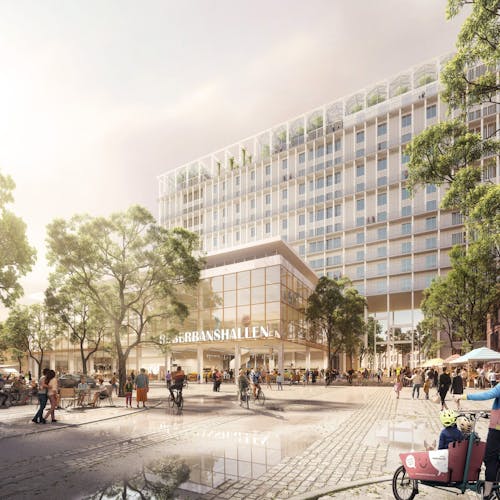UAE Pavilion Osaka Expo 2025
A celebration of the iconic Emirati date palm. And a shared vision for a future based on material innovations, traditional crafts, and the cultural and natural heritage of the UAE and Japan.

Location
Osaka, Japan
Year
2024 — 2025
Client
Salama Bint Hamdan Al Nahyan Foundation
Role
Lead landscape architect
Partners & Collaborators
Datecreed, Aterlier Bruckner
Challenges
Services
The landscape for the UAE Pavilion at Expo 2025 Osaka, Kansai is a celebration of UAE’s iconic date palm tree.
It is also a testament to global and interdisciplinary collaboration, uniting Emirati, Japanese, and international expertise in a collective design process that fuses tradition with innovation.

Bridging the UAE and Japan
With more than 40 million date palms in the UAE, the palm and its fruits are a vital part of the country’s culture, history, and farming economy. Yet these many palms also represent significant agricultural waste: fronds are routinely trimmed, generating organic waste, and date pits are often discarded.
As a natural extension of the Pavilion’s ‘Earth to Ether’ journey, the landscape transforms waste into possibility — demonstrating how a nation’s heritage and traditional practices can inspire and even drive future innovation.
By bridging the UAE and Japan through deeply rooted agricultural practices, traditional crafts, and shared cultural and natural values, the UAE Pavilion landscape reinterprets conventional uses of date palm materials to create new methods and materials that enable new forms of material exploration for the future of landscape design.


“For SLA, it is an amazing honor to be part of the UAE Pavilion's Earth to Ether Design Collective representing UAE in Osaka and a culmination of our 10-year commitment in the country. With the UAE Pavilion's landscape, we present new material innovations and designs built upon the legacy and traditions of both the UAE and Japan. The goal is to showcase how natural and cultural heritage can drive innovation through interdisciplinary experimentation and collaboration - for a flourishing future for all life, from Earth to Ether.”
— Rasmus Astrup, Design Principal & Partner
Landscape as living dialogue
The UAE Pavilion landscape is a living dialogue between cultures, drawing inspiration from two historical agricultural practices in Japan and the UAE: Japans’ Satoyama forest and the UAE date farm.
In both practices, communities have coexisted with the land in ways that instinctively conserved biodiversity and sustained livelihoods.
The entire landscape is organized according to the Japanese textile method Boro, with the different landscape elements ‘patched’ together into zones for queuing, lounging, shading, and learning – creating a rich and multilayered entrance experience inspired by the UAE’s Majlis and Japan’s Genkan.


Traditional crafts and ancient agriculture
The Japanese Satoyama woodlands are represented by Sawtooth Qak and Japanese Red Pines that frame the front landscape, evoking the harmonious coexistence of nature and people.
Guests queueing for the entrance can enjoy the shade of a pergola made from Japanese cedar, paired with a canopy featuring Emirati al-khoos patterns, a traditional form of weaving using dried palm leaves.
The pavilion’s outdoor furniture artfully combines Japanese woodworking crafts with recycled agricultural date palm waste, including Dateform – a pioneering date seed-based material from the UAE.


The date palm in all its form
In the UAE Pavilion landscape, material innovation is taken to new heights. Here, you are literally walking on dates.
The Japanese oaks and pines are planted in gravel made of date pits – providing an informal and nature-based ‘souvenir’, especially for the pavilions’ younger visitors.
The landscape’s different pavers are made from Datecrete—an organic alternative to cement crafted from crushed date seeds, developed in collaboration with the young UAE material innovator startup of husband-and-wife Sara Farha and Khaled Shalkha.
With 60% of its composition made from agricultural waste and no cement, Datecrete responds to one of the world’s most urgent challenges — the decarbonization of construction materials.
The final testing and approvals for Datecrete were completed just weeks before the EXPO opening, making its use in the pavilion a live illustration of innovation-in-action.




Bridging cultures, bridging natures
The UAE Pavilion landscape builds on a legacy of global collaboration, from Expo ’70 to Expo 2020 Dubai.
The pavilion reaffirms the enduring partnership between the UAE and Japan and embodies a shared belief in the power of nature, culture, and collective innovation to shape a sustainable and flourishing future for all life, from Earth to Ether.
The 2025 Expo in Osaka, Kansai runs from April 13 to October 13, 2025.















